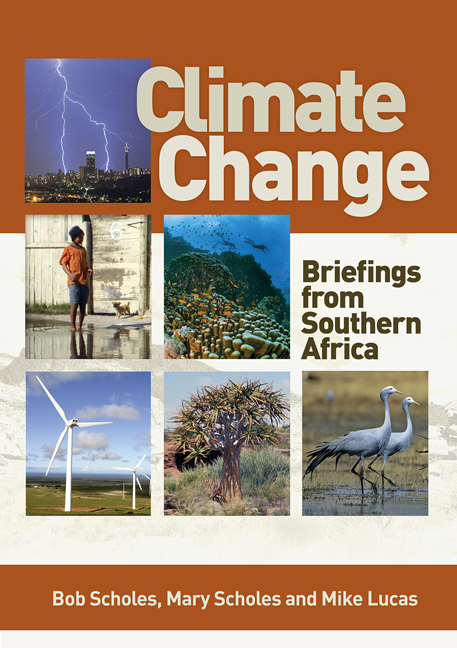Book contents
- Frontmatter
- Acknowledgements
- Contents
- Foreword
- Acronyms and abbreviations
- Preface
- How do governments assess climate change?
- Section 1 Earth system science: The processes that underlie climate change
- Introduction
- 1 Why is Earth habitable?
- 2 How do greenhouse gases regulate Earth's temperature?
- 3 Is water vapour the most important greenhouse gas?
- 4 Why are clouds the wild card in climate change?
- 5 Is climate change just part of a long-term natural cycle?
- 6 Are climate variations just due to volcanoes or other Earth processes?
- 7 How do El Niño and La Niña events affect South African weather?
- 8 How hot might it get in South Africa this century?
- 9 How might the rainfall in Southern Africa change in the twenty-first century?
- 10 Are extreme weather events related to climate change?
- 11 How do land-use changes and deforestation affect global warming?
- 12 What is South Africa's contribution to global warming?
- 13 What happens to carbon dioxide emissions?
- 14 Can ecosystems keep sucking up carbon dioxide from fossil fuel burning?
- 15 Could ocean currents slow down or change direction?
- 16 Is there any chance of runaway global warming?
- Section 2 Consequences of a changing climate for the Southern African environment
- Section 3 Consequences of a changing climate for society
- Section 4 What we can do to avoid and adapt to climate change
- Codicil Is there a dangerous level of climate change?
- Glossary
- List of figures
- References
- Reading list
- Index
9 - How might the rainfall in Southern Africa change in the twenty-first century?
from Section 1 - Earth system science: The processes that underlie climate change
Published online by Cambridge University Press: 20 April 2018
- Frontmatter
- Acknowledgements
- Contents
- Foreword
- Acronyms and abbreviations
- Preface
- How do governments assess climate change?
- Section 1 Earth system science: The processes that underlie climate change
- Introduction
- 1 Why is Earth habitable?
- 2 How do greenhouse gases regulate Earth's temperature?
- 3 Is water vapour the most important greenhouse gas?
- 4 Why are clouds the wild card in climate change?
- 5 Is climate change just part of a long-term natural cycle?
- 6 Are climate variations just due to volcanoes or other Earth processes?
- 7 How do El Niño and La Niña events affect South African weather?
- 8 How hot might it get in South Africa this century?
- 9 How might the rainfall in Southern Africa change in the twenty-first century?
- 10 Are extreme weather events related to climate change?
- 11 How do land-use changes and deforestation affect global warming?
- 12 What is South Africa's contribution to global warming?
- 13 What happens to carbon dioxide emissions?
- 14 Can ecosystems keep sucking up carbon dioxide from fossil fuel burning?
- 15 Could ocean currents slow down or change direction?
- 16 Is there any chance of runaway global warming?
- Section 2 Consequences of a changing climate for the Southern African environment
- Section 3 Consequences of a changing climate for society
- Section 4 What we can do to avoid and adapt to climate change
- Codicil Is there a dangerous level of climate change?
- Glossary
- List of figures
- References
- Reading list
- Index
Summary
The projection of future rainfall is much less certain than projections of future temperature. South Africa is likely to become drier in the west and southwest, and wetter in the east. Although the rainfall changes are projected to be smaller than the average current variation between years, they would nevertheless be significant for agriculture and water supply.
We can confidently predict that a warmer world, overall, will be wetter. All the prehistoric data, such as reduced rainfall during past glacial periods, show this, as do all climate models. However, for some specific regions, including parts of Southern Africa, this will not necessarily be true. The belt of arid lands north and south of the tropics is likely to become drier even as the rest of the world becomes wetter. The details of future trends in rainfall at local scale are much harder to predict than, for instance, the future rise in temperature. The pattern of rainfall over South Africa during the past century provides no widespread, clear evidence of change, either up or down. Climate modellers deal with the variation between model predictions by calculating averages over a large number of runs of different models, called ensembles.
Broadly speaking, the future geographical distribution of rainfall in South Africa is likely to be similar to the present pattern, only more so – thus dry places are projected to get drier and wet places may get wetter.
Most of Southern Africa will remain a predominantly summer rainfall area. It is believed that the south-western Cape will remain a predominantly winter rainfall area, but may see some decreases in rainfall overall, with small increases in summer rainfall. Summer rainfall in the fynbos biome could be ecologically damaging – the main reason why there are so few grasses in the fynbos is the long, dry summers. Invasion of grasses taking advantage of wetter summer conditions would change the historical fire pattern from intense fires once every ten to twenty years, which fynbos needs to maintain plant diversity, to less intense but more frequent grass-fuelled fires.
The southern and eastern Cape represent a transition zone between the summer and winter rainfall regions. Changes in extreme rainfall events may be quite dramatic here.
- Type
- Chapter
- Information
- Climate ChangeBriefings from Southern Africa, pp. 26 - 28Publisher: Wits University PressPrint publication year: 2015



